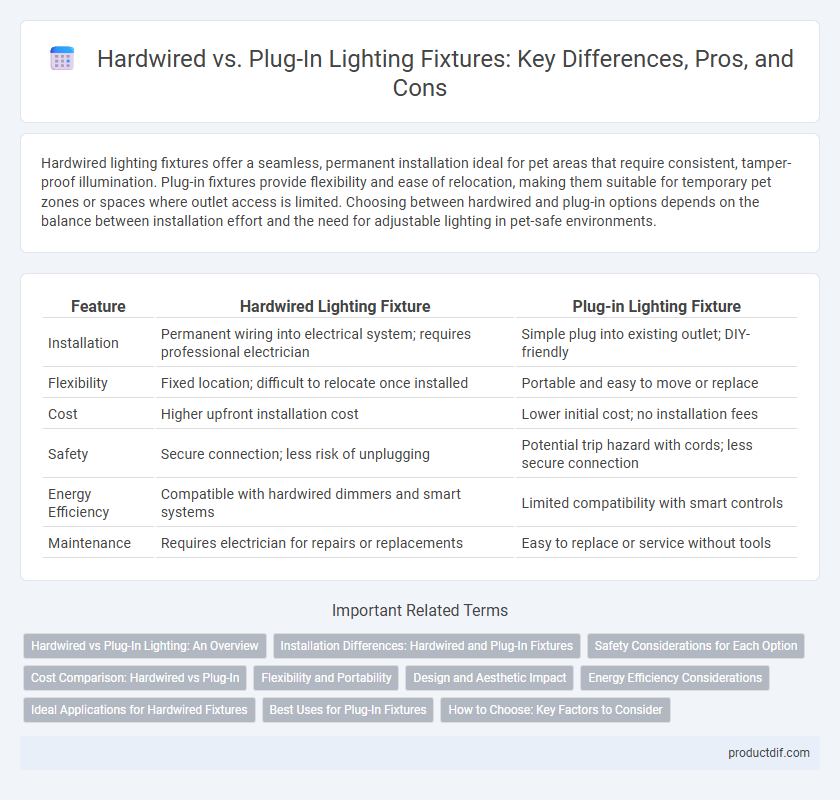Hardwired lighting fixtures offer a seamless, permanent installation ideal for pet areas that require consistent, tamper-proof illumination. Plug-in fixtures provide flexibility and ease of relocation, making them suitable for temporary pet zones or spaces where outlet access is limited. Choosing between hardwired and plug-in options depends on the balance between installation effort and the need for adjustable lighting in pet-safe environments.
Table of Comparison
| Feature | Hardwired Lighting Fixture | Plug-in Lighting Fixture |
|---|---|---|
| Installation | Permanent wiring into electrical system; requires professional electrician | Simple plug into existing outlet; DIY-friendly |
| Flexibility | Fixed location; difficult to relocate once installed | Portable and easy to move or replace |
| Cost | Higher upfront installation cost | Lower initial cost; no installation fees |
| Safety | Secure connection; less risk of unplugging | Potential trip hazard with cords; less secure connection |
| Energy Efficiency | Compatible with hardwired dimmers and smart systems | Limited compatibility with smart controls |
| Maintenance | Requires electrician for repairs or replacements | Easy to replace or service without tools |
Hardwired vs Plug-In Lighting: An Overview
Hardwired lighting fixtures are permanently connected to the electrical system, offering a seamless and cleaner look with no visible cords, ideal for enhanced home aesthetics and safety. Plug-in lighting fixtures provide flexibility and ease of installation, allowing users to relocate or replace them without professional assistance, suitable for temporary or rental spaces. Choosing between hardwired vs plug-in lighting depends on factors like installation complexity, mobility needs, and design preferences.
Installation Differences: Hardwired and Plug-In Fixtures
Hardwired lighting fixtures require direct electrical connections inside wall junction boxes, ensuring a permanent and streamlined installation often preferred for ceiling lights or chandeliers. Plug-in fixtures feature a cord that connects to existing outlets, allowing easy relocation and simpler setup without altering wall wiring. Choosing between hardwired and plug-in lighting depends on the desired aesthetic, installation complexity, and electrical access in the intended space.
Safety Considerations for Each Option
Hardwired lighting fixtures offer enhanced safety through secure electrical connections, reducing risks of accidental unplugging and electrical faults. Plug-in fixtures provide convenience but require careful inspection of plugs and cords to prevent hazards such as frayed wires or loose connections. Proper installation by a certified electrician and adherence to local electrical codes ensure optimal safety for both hardwired and plug-in lighting options.
Cost Comparison: Hardwired vs Plug-In
Hardwired lighting fixtures typically involve higher upfront installation costs due to professional electrical work and potential modifications to the wiring system. In contrast, plug-in fixtures offer lower initial expenses as they simply require an available outlet, making them more budget-friendly for quick setup. Over time, hardwired fixtures may reduce maintenance costs through increased stability and integration, whereas plug-in units might incur extra costs from wear on cords and outlets.
Flexibility and Portability
Hardwired lighting fixtures offer a permanent electrical connection that ensures stability and a clean aesthetic but lack the flexibility to be easily moved or repositioned. Plug-in fixtures provide superior portability and adaptability, allowing users to relocate or adjust lighting setups without electrical work, ideal for temporary or evolving spaces. Choosing between hardwired and plug-in depends on the need for fixed installation versus ease of movement and convenience.
Design and Aesthetic Impact
Hardwired lighting fixtures offer a sleek, seamless design that integrates directly into the electrical system, minimizing visible cords and enhancing a clean, minimalist aesthetic. Plug-in fixtures provide flexibility in placement and style but often require visible cords, which can disrupt the visual flow in contemporary or refined interior designs. Choosing hardwired options supports a polished, architectural look ideal for modern and high-end spaces seeking subtle elegance.
Energy Efficiency Considerations
Hardwired lighting fixtures often provide greater energy efficiency by ensuring a direct electrical connection, reducing power loss compared to plug-in models that may experience voltage drops through cords and connectors. Energy-efficient hardwired systems typically support advanced controls such as dimmers and smart home integration, optimizing energy consumption throughout usage. However, plug-in fixtures offer flexibility in placement and ease of replacement, which can indirectly influence overall energy use based on user habits and fixture accessibility.
Ideal Applications for Hardwired Fixtures
Hardwired lighting fixtures are ideal for permanent installations in residential and commercial spaces where consistent power supply and seamless integration with existing electrical systems are essential. These fixtures suit applications such as kitchens, hallways, and offices where a clean, streamlined look without visible cords is preferred. Hardwired lights also enhance safety by reducing trip hazards and are commonly used in ceiling-mounted and recessed lighting setups.
Best Uses for Plug-In Fixtures
Plug-in lighting fixtures offer flexibility and ease of installation, making them ideal for rental spaces or temporary setups where hardwiring isn't feasible. They are well-suited for areas requiring frequent adjustments, such as home offices or event venues, allowing users to reposition or replace fixtures without electrical work. Perfect for renters or those seeking quick upgrades, plug-in fixtures provide versatile illumination without permanent changes to the wiring system.
How to Choose: Key Factors to Consider
Choosing between hardwired and plug-in lighting fixtures depends on installation complexity, flexibility, and electrical capacity. Hardwired fixtures offer a permanent, streamlined look with direct connection to the electrical system, ideal for new constructions or major renovations. Plug-in fixtures provide easy installation and portability, suitable for renters or temporary setups where minimal wiring is preferred.
Hardwired vs Plug-in Infographic

 productdif.com
productdif.com